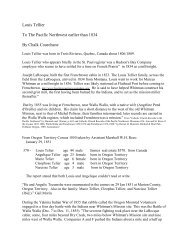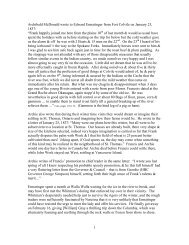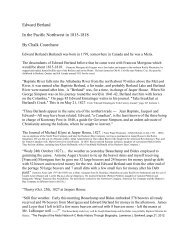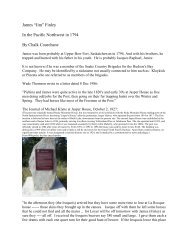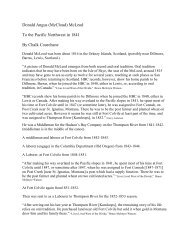(352) Ref: Wikipedia, <strong>the</strong> free encyclopedia: is; “A nitrogen fixing shrub in <strong>the</strong> genus Purshia,native to mountainous areas of western North America ranging from sou<strong>the</strong>astern British Columbia in <strong>the</strong> north, eastto Montana <strong>and</strong> south to California <strong>and</strong> New Mexico. It grows on arid mountainsides; in California it occursbetween 700–3,400 m above sea level (Jepson), but lower fur<strong>the</strong>r north, at 320–1,065 m in British Columbia.”(353) Ref: Lonicera Caprifolium: definition of Lonicera Caprifolium in <strong>the</strong> ….: is a branchyclimbing shrub of <strong>the</strong> honeysuckle (or Italian woodbine) family, typically attaining a height of 4–6 m. Loniceracaprifolium is a deciduous climbing shrub with fragrant yellow-white flowers in axillary whorls.(354) Ref: How to Grow Columbine: Perennial Flowers By The Gardener’s Network: is an earlysummer perennial native to Asia, Europe, <strong>and</strong> North America. Columbines produce large, showy blooms of single<strong>and</strong> bicolor patterns on airy plants with blue-green foliage from late spring to early summer. Colors include shadesof yellow, white, pink, blue, purple <strong>and</strong> combinations.(355) Ref: Wikipedia, <strong>the</strong> free encyclopedia: “Dalea; commonly known as Prairie Clover, is a genus ofplants in <strong>the</strong> pea family Fabaceae.”(356) Ref: Wikipedia, <strong>the</strong> free encyclopedia: “Oberonia is a genus of flowering plant s from <strong>the</strong> orchidfamily, Orchidaceae.”(357) Ref: Wikipedia, <strong>the</strong> free encyclopedia: , a.k.a. Prickly-pear; “Also known as nopales, or PaddleCactus from <strong>the</strong> resemblance to <strong>the</strong> ball-<strong>and</strong>-paddle toy; a genus in <strong>the</strong> cactus family, Cactacea..”(358) Ref: Wikipedia, <strong>the</strong> free encyclopedia: “Rubiaceae is a family of flowering plants, variouslycalled <strong>the</strong> madder family, bedstraw family or coffee family. O<strong>the</strong>r common plants included are gardenia, cinchona(whose bark contains quinine), sweet woodruff, partridgeberry, gambier, ixora, <strong>and</strong> noni.”(359) Ref: Wikipedia, <strong>the</strong> free encyclopedia: is a genus of herbs, sub-shrubs, shrubs, <strong>and</strong> small trees in <strong>the</strong>family Chenopodiaceae, native to Africa, Asia, <strong>and</strong> Europe. Plants in this genus typically grow on flat, often dry<strong>and</strong>/or somewhat saline soils, with some species in salt marshes. A few species are tumbleweeds.(360) Ref: Wikipedia, <strong>the</strong> free encyclopedia: Common varieties of <strong>the</strong> Ambrosia genus are ragweeds,bitterweeds <strong>and</strong> bloodweeds. “Ambrosia is a Genus: of a group of about 40 species of weedy plants of <strong>the</strong> familyAsteraceae. Most species are native to North America.”(361) Ref: Wikipedia, <strong>the</strong> free encyclopedia: “Armeria is <strong>the</strong> botanical name for a genus of floweringplants. These plants are sometimes known as "thrift" or as <strong>the</strong> "sea pinks" as <strong>the</strong>y are often found on coastlines. Thegenus counts over a hundred
species, etc.”(362) Ref: Wikipedia, <strong>the</strong> free encyclopedia: “Poaceae or Gramineae is a family in <strong>the</strong> ClassLiliopsida (<strong>the</strong> monocots) of <strong>the</strong> flowering plants. Plants of this family are usually called grasses, or, to distinguish<strong>the</strong>m from o<strong>the</strong>r graminoids, true grasses; <strong>the</strong> shrub or tree-like plants in this family are called bamboo (<strong>the</strong>re arealso herbaceous, non-woody bamboos). There are about 600 genera <strong>and</strong> some 9,000–10,000 or more species ofgrasses (Kew Index of World Grass Species).”(363) Ref: Wikipedia, <strong>the</strong> free encyclopedia: “Ledum is a genus name formerly widely recognized in <strong>the</strong>family Ericaceae, including 8 species of evergreen shrubs native to cool temperate <strong>and</strong> sub-arctic regions of <strong>the</strong>Nor<strong>the</strong>rn Hemisphere <strong>and</strong> commonly known as Labrador Tea. Recent genetic evidence <strong>has</strong> shown that <strong>the</strong> speciespreviously treated in this genus are correctly placed in <strong>the</strong> genus Rhododendron, where <strong>the</strong>y are now treated asRhododendron subset Ledum.”(364) Ref: Wikipedia, <strong>the</strong> free encyclopedia: “Myrica is a genus of about 35–50 species of small trees <strong>and</strong>shrubs in <strong>the</strong> family Myricaceae, order Fagales. Common names include Bayberry, Bay-rum tree, C<strong>and</strong>leberry,Sweet Gale, <strong>and</strong> Wax-myrtle.”(365) Ref: US Military Expeditions in Okanagan County – Boom Town Tales & Historic People: “TheSpokane tribe, who are generally included under <strong>the</strong> name Fla<strong>the</strong>ads subsist for <strong>the</strong> most part on roots, fish, berries<strong>and</strong> game. At <strong>the</strong> opening of spring, in March <strong>and</strong> April, or as soon as <strong>the</strong> snow disappears, <strong>the</strong>y begin to search fora root resembling <strong>the</strong> cammass, which <strong>the</strong>y call pox-pox. This lasts <strong>the</strong>m till <strong>the</strong> beginning of May, when it givesplace to a bitter root, termed spatylon. In June <strong>the</strong> izwa or cammass, comes in season. This root was thought bymany of us to have <strong>the</strong> taste of boiled chestnuts.”CHAPTER XXII(366) Ref: Wikipedia Encyclopedia: “Robert Campbell (21 February 1808 – 9 May 1894) was a Hudson’s BayCompany fur trader <strong>and</strong> explorer. He explored a large part of <strong>the</strong> sou<strong>the</strong>rn Yukon <strong>and</strong> established Fort Frances,Yukon on Frances Lake in <strong>the</strong> Liard River basin <strong>and</strong> Fort Selkirk, Yukon at <strong>the</strong> juncture of <strong>the</strong> Yukon River <strong>and</strong> <strong>the</strong>Pelly River. He was for a time in charge of Fort Halkett. Campbell Peak, just south of <strong>the</strong> British Columbiacommunity of Liard River, is named after him.”(367) Ref: Encyclopedia Brittanica: “U.S. Presbyterian missionary who, with his wife, Eliza (née Hart), in 1836established <strong>the</strong> Lapwai Mission (near present-day Lewiston, Idaho) with <strong>the</strong> first white home, church, <strong>and</strong> school inwhat is now Idaho.”Ref: Wikipedia: “Henry Harmon Spalding (1803 - 1874) <strong>and</strong> his wife Eliza Hart Spalding (1807 - 1851) wereprominent Presbyterian missionaries <strong>and</strong> educators working primarily with <strong>the</strong> Nez Perce in <strong>the</strong> U.S. PacificNorthwest. The Spaldings <strong>and</strong> <strong>the</strong>ir fellow missionaries were among <strong>the</strong> earliest Americans to travel across <strong>the</strong>western plains, through <strong>the</strong> Rocky Mountains <strong>and</strong> into <strong>the</strong> l<strong>and</strong>s of <strong>the</strong> Pacific Northwest to <strong>the</strong>ir religious missionsin what would become <strong>the</strong> states of Idaho <strong>and</strong> Washington.”(367) From 1841-46, Archibald Mc Kinley was in charge of Fort Nez Perce (later renamed Fort Walla Walla).Ref: Fort Nez Perce – <strong>Oregon</strong> History Project: “Archibald Mc kinley was chief trader for <strong>the</strong> Hudson’s BayCompany at Fort Nez Perce.”
- Page 1 and 2:
Don Ubben has been researching the
- Page 3:
Buchanan, of Lexington, Ky., joined
- Page 7 and 8: (32) Edwin Bryant, also makes menti
- Page 9 and 10: On Dec. 23, 1819 Harriet married (2
- Page 11 and 12: William S. Clark left Independence
- Page 13 and 14: Lee Co., VA). James & Hannah moved
- Page 15 and 16: Dorintha Shaunce, was born Feb. 13,
- Page 17 and 18: Chimney Rock is 4,226 feet (1,288 m
- Page 19 and 20: 1870 at Rosebud Indian Reservation,
- Page 21 and 22: with the formula NaHCO3. Sodium bic
- Page 23 and 24: was a matter of pure chance that th
- Page 25 and 26: (141) Ref: Ribes irriguum-Plants Fo
- Page 27 and 28: (153) Ref: Emigrants to Oregon in 1
- Page 29 and 30: southern route into Oregon Territor
- Page 31 and 32: wagons.” William D. had already d
- Page 33 and 34: CHAPTER X(183) William Stokes was b
- Page 35 and 36: York Supreme Court, in 1804 Chief J
- Page 37 and 38: (204) Ref: Brittanica Encyclopedia:
- Page 39 and 40: (214) Ref: The Applegate Trail Inte
- Page 41 and 42: Benjamin born in 1818; died in 1852
- Page 43 and 44: (247) Ref: Latin - Definition and M
- Page 45 and 46: greatest explorers. The maps he dre
- Page 47 and 48: an intelligent gentleman, and is al
- Page 49 and 50: and pioneer in the Oregon Country i
- Page 51 and 52: Scrophulariaceae, but following rec
- Page 53 and 54: (323) Ref: Fourth edition of Rev. S
- Page 55: celandine of the poppy family Papav



